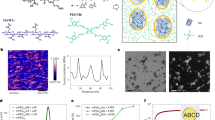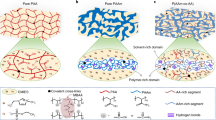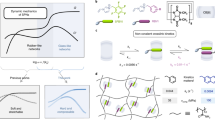Abstract
Polymer gels are the only viable class of synthetic materials with a Young’s modulus below 100 kPa conforming to biological applications1,2,3, yet those gel properties require a solvent fraction4,5,6,7. The presence of a solvent can lead to phase separation, evaporation and leakage on deformation, diminishing gel elasticity and eliciting inflammatory responses in any surrounding tissues. Here, we report solvent-free, supersoft and superelastic polymer melts and networks prepared from bottlebrush macromolecules. The brush-like architecture expands the diameter of the polymer chains, diluting their entanglements without markedly increasing stiffness. This adjustable interplay between chain diameter and stiffness makes it possible to tailor the network’s elastic modulus and extensibility without the complications associated with a swollen gel. The bottlebrush melts and elastomers exhibit an unprecedented combination of low modulus (∼100 Pa), high strain at break (∼1,000%), and extraordinary elasticity, properties that are on par with those of designer gels8,9.
This is a preview of subscription content, access via your institution
Access options
Subscribe to this journal
Receive 12 print issues and online access
$259.00 per year
only $21.58 per issue
Buy this article
- Purchase on Springer Link
- Instant access to full article PDF
Prices may be subject to local taxes which are calculated during checkout




Similar content being viewed by others
References
Levental, I., Georges, P. C. & Janmey, P. A. Soft biological materials and their impact on cell function. Soft Matter 3, 299–306 (2007).
Williams, D. F. On the mechanisms of biocompatibility. Biomaterials 29, 2941–2953 (2008).
Rus, D. & Tolley, M. T. Design, fabrication and control of soft robots. Nature 521, 467–475 (2015).
Wichterle, O. & Lím, D. Hydrophilic gels for biological use. Nature 185, 117–118 (1960).
Discher, D. E., Janmey, P. & Wang, Y. L. Tissue cells feel and respond to the stiffness of their substrate. Science 310, 1139–1143 (2005).
Anseth, K. S., Bowman, C. N. & Brannon-Peppas, L. Mechanical properties of hydrogels and their experimental determination. Biomaterials 17, 1647–1657 (1996).
Baumberger, T., Caroli, C. & Martina, D. Solvent control of crack dynamics in a reversible hydrogel. Nature Mater. 5, 552–555 (2006).
Sun, J. Y. et al. Highly stretchable and tough hydrogels. Nature 489, 133–136 (2012).
Sun, T. L. et al. Physical hydrogels composed of polyampholytes demonstrate high toughness and viscoelasticity. Nature Mater. 12, 932–937 (2013).
Edwards, S. F. & Doi, M. The Theory of Polymer Dynamics (Oxford Univ. Press, 1986).
de Gennes, P. G. J. Reptation of a polymer chain in the presence of fixed obstacles. Chem. Phys. 55, 572–579 (1971).
Patel, S. K., Malone, S., Cohen, C., Gillmor, J. R. & Colby, R. H. Elastic modulus and equilibrium swelling of poly(dimethylsiloxane) networks. Macromolecules 25, 5241–5251 (1992).
Everaers, R. Entanglement effects in defect-free model polymer networks. New J. Phys. 1, 12.1–12.54 (1999).
Urayama, K., Kawamure, T. & Kohjiya, S. Elastic modulus and equilibrium swelling of networks crosslinked by end-linking oligomethysiloxne at solutions state. J. Chem. Phys. 105, 4833–4840 (1996).
Rubinstein, M. & Colby, R. H. Network modulus and superelasticity. Macromolecules 27, 3191–3198 (1994).
Zhang, K., Lackey, M., Cui, J. & Tew, G. N. Gels based on cyclic polymers. J. Am. Chem. Soc. 133, 4140–4148 (2011).
Landau, L. D. & Lifshitz, E. M. Theory of Elasticity Vol. 7 (Pergamon, 1986).
Boal, D. H. Mechanics of Cell 2nd edn (Cambridge Univ. Press, 2002).
Inkson, N. J., Graham, R. S., McLeish, T. C. B., Groves, D. J. & Fernyhough, C. M. Viscoelasticity of monodisperse comb polymer melts. Macromolecules 39, 4217–4227 (2006).
Kapnistos, M., Vlassopoulos, D., Roovers, J. & Leal, L. G. Linear rheology of architecturally complex macromolecules: Comb polymers with linear backbones. Macromolecules 38, 7852–7862 (2005).
Fetters, L. J., Lohse, D. J., Garcia-Franco, C. A., Brant, P. & Richter, D. Prediction of melt state Poly(R-olefin) rheological properties: The unsuspected role of the average molecular weight per backbone bond. Macromolecules 35, 10096–10101 (2002).
Yamazaki, H. et al. Dynamic viscoelasticity of poly(butyl acrylate) elastomers containing dangling chains with controlled lengths. Macromolecules 44, 8829–8834 (2011).
Pakula, T. et al. Molecular brushes as super-soft elastomers. Polymer 47, 7198–7206 (2006).
Hu, M., Xia, Y., McKenna, G. B., Kornfield, J. A. & Grubbs, R. H. Linear rheological response of a series of densely branched brush polymers. Macromolecules 44, 6935–6943 (2011).
Dalsin, S. J., Hillmyer, M. A. & Bates, F. S. Linear rheology of polyolefin-based bottlebrush polymers. Macromolecules 48, 4680–4691 (2015).
Zhen, C., Carillo, J. M., Sheiko, S. S. & Dobrynin, A. V. Computer simulations of bottlebrushes: From melts to soft networks. Macromolecules 48, 5006–5015 (2015).
Kavassalis, T. A. & Noolandi, J. Entanglement scaling in polymer melts and solutions. Macromolecules 22, 2709–2720 (1989).
Matyjaszewski, K. Atom transfer radical polymerization (ATRP): Current status and future perspectives. Macromolecules 45, 4015–4039 (2012).
Sumerlin, B. S., Neugebauer, D. & Matyjaszewski, K. Initiation efficiency in the synthesis of molecular brushes by grafting from via atom transfer radical polymerization. Macromolecules 38, 702–708 (2005).
Sheiko, S. S. et al. Measuring molecular weight by atomic force microscopy. J. Am. Chem. Soc. 125, 6725–6728 (2003).
Lomellini, P. Effect of chain length on the network modulus and entanglement. Polymer 33, 1255–1259 (1992).
van Gurp, M. & Palmen, J. Time-temperature superposition for polymeric blends. Rheol. Bull. 67, 5–8 (1998).
des Cloizeaux, J. Double reptation vs. simple reptation in polymer melts. Europhys. Lett. 5, 437–442 (1988).
Acknowledgements
We gratefully acknowledge financial support from the National Science Foundation (DMR 1409710, DMR 1122483, DMR 1407645 and DMR 1436201). J.P. acknowledges financial support provided by a Polish Ministry of Science and Higher Education Grant (IP2012 005072). We also thank E. Zhulina for illuminating discussion, R. Colby of Penn State University for training in rheological techniques, and E. T. Samulski for reviewing the paper.
Author information
Authors and Affiliations
Contributions
W.F.M.D. performed LB-AFM experiments and analysis, rheology experiments and analysis, and wrote the manuscript. J.B. and K.M. synthesized BA bottlebrush polymers and performed GPC and chain cleavage analysis. M.V.-V. synthesized pDMS elastomers, J.P. performed computer simulations of bottlebrush melts, and M.R. and A.V.D. provided theoretical predictions. S.S.S. was the primary investigator.
Corresponding author
Ethics declarations
Competing interests
The authors declare no competing financial interests.
Supplementary information
Supplementary Information
Supplementary Information (PDF 1970 kb)
Supplementary Movie 1
Supplementary Movie 1 (MOV 1002 kb)
Rights and permissions
About this article
Cite this article
Daniel, W., Burdyńska, J., Vatankhah-Varnoosfaderani, M. et al. Solvent-free, supersoft and superelastic bottlebrush melts and networks. Nature Mater 15, 183–189 (2016). https://doi.org/10.1038/nmat4508
Received:
Accepted:
Published:
Issue Date:
DOI: https://doi.org/10.1038/nmat4508
This article is cited by
-
Self-compliant ionic skin by leveraging hierarchical hydrogen bond association
Nature Communications (2024)
-
Conductive and elastic bottlebrush elastomers for ultrasoft electronics
Nature Communications (2023)
-
Non-flammable solvent-free liquid polymer electrolyte for lithium metal batteries
Nature Communications (2023)
-
Stimuli-responsive rotaxane-branched dendronized polymers with tunable thermal and rheological properties
Nature Communications (2023)
-
Forensics of polymer networks
Nature Materials (2023)



